
The Big Bang is a physical theory that describes how the universe expanded from an initial state of high density and temperature. The notion of an expanding universe was first scientifically originated by physicist Alexander Friedmann in 1922 with the mathematical derivation of the Friedmann equations. The earliest empirical observation of the notion of an expanding universe is known as Hubble's law, published in work by physicist Edwin Hubble in 1929, which discerned that galaxies are moving away from Earth at a rate that accelerates proportionally with distance. Independent of Friedmann's work, and independent of Hubble's observations, physicist Georges Lemaître proposed that the universe emerged from a "primeval atom" in 1931, introducing the modern notion of the Big Bang.

Physical cosmology is a branch of cosmology concerned with the study of cosmological models. A cosmological model, or simply cosmology, provides a description of the largest-scale structures and dynamics of the universe and allows study of fundamental questions about its origin, structure, evolution, and ultimate fate. Cosmology as a science originated with the Copernican principle, which implies that celestial bodies obey identical physical laws to those on Earth, and Newtonian mechanics, which first allowed those physical laws to be understood.
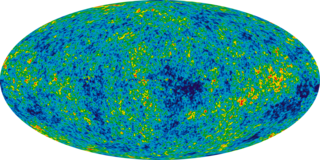
In physical cosmology, cosmic inflation, cosmological inflation, or just inflation, is a theory of exponential expansion of space in the very early universe. Following the inflationary period, the universe continued to expand, but at a slower rate. The re-acceleration of this slowing expansion due to dark energy began after the universe was already over 7.7 billion years old.

Cosmogony is any model concerning the origin of the cosmos or the universe.
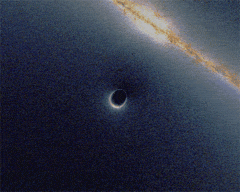
A gravitational singularity, spacetime singularity, or simply singularity, is a theoretical condition in which gravity is predicted to be so intense that spacetime itself would break down catastrophically. As such, a singularity is by definition no longer part of the regular spacetime and cannot be determined by "where" or "when". Gravitational singularities exist at a junction between general relativity and quantum mechanics; therefore, the properties of the singularity cannot be described without an established theory of quantum gravity. Trying to find a complete and precise definition of singularities in the theory of general relativity, the current best theory of gravity, remains a difficult problem. A singularity in general relativity can be defined by the scalar invariant curvature becoming infinite or, better, by a geodesic being incomplete.

A Brief History of Time: From the Big Bang to Black Holes is a book on theoretical cosmology by the physicist Stephen Hawking. It was first published in 1988. Hawking wrote the book for readers who had no prior knowledge of physics.

Catherine Lucy Hawking is an English journalist, novelist, educator, and philanthropist. She is the daughter of the theoretical physicist Stephen Hawking and writer Jane Wilde Hawking. She lives in London, and is a children's novelist and science educator.
Stephen Hawking's Universe is an astronomical documentary from 1997 made for the PBS featuring the theoretical physicist Stephen Hawking. The six-episode series discusses the history of astronomy as well as black holes and dark matter.

Hawking is a 2004 biographical drama television film directed by Philip Martin and written by Peter Moffat. Starring Benedict Cumberbatch, it chronicles Stephen Hawking's early years as a PhD student at the University of Cambridge, following his search for the beginning of time, and his struggle against motor neurons disease. It premiered in the UK in April 2004.
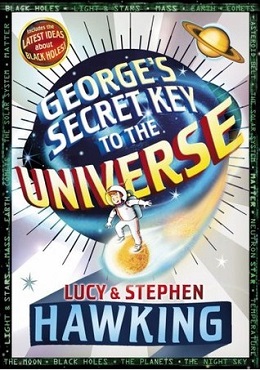
George's Secret Key to the Universe is a 2007 children's book written by Lucy and Stephen Hawking with Christophe Galfard. Upon its release, the book received mixed reviews, and was followed by five sequels, George's Cosmic Treasure Hunt in 2009, George and the Big Bang in 2011, George and the Unbreakable Code in 2014 and George and the Blue Moon in 2016 and George and the Ship of Time in 2018.

Wrinkles in Time is a book on cosmology by the Nobel laureate physicist George Smoot and Keay Davidson, a science writer for the San Francisco Examiner. It was published in 1994 by William Morrow in hardback.

Stephen William Hawking was an English theoretical physicist, cosmologist, and author who was director of research at the Centre for Theoretical Cosmology at the University of Cambridge. Between 1979 and 2009, he was the Lucasian Professor of Mathematics at Cambridge, widely viewed as one of the most prestigious academic posts in the world.
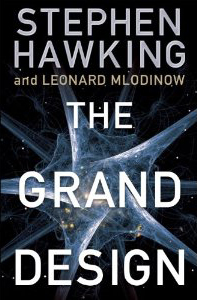
The Grand Design is a popular-science book written by physicists Stephen Hawking and Leonard Mlodinow and published by Bantam Books in 2010. The book examines the history of scientific knowledge about the universe and explains eleven-dimensional M-theory. The authors of the book point out that a Unified Field Theory may not exist.

The First Three Minutes: A Modern View of the Origin of the Universe is a book by American physicist and Nobel Laureate Steven Weinberg.

Cycles of Time: An Extraordinary New View of the Universe is a science book by mathematical physicist Roger Penrose published by The Bodley Head in 2010. The book outlines Penrose's Conformal Cyclic Cosmology (CCC) model, which is an extension of general relativity but opposed to the widely supported multidimensional string theories and cosmological inflation following the Big Bang.
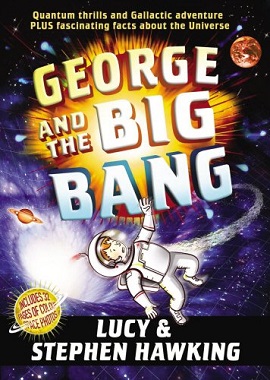
George and the Big Bang is a 2011 children's book written by Stephen and Lucy Hawking. The book is the third book in the George series, following George's Secret Key to the Universe and George's Cosmic Treasure Hunt. George and the Big Bang is available in paperback, hardback and audio versions.

George and the Unbreakable Code is a 2014 children's book written by Stephen and Lucy Hawking. The book is the fourth book in the George series, following George's Secret Key to the Universe, George's Cosmic Treasure Hunt, and George and the Big Bang, and preceding George and the Blue Moon.

Leticia Corral is a Mexican mathematician, astrophysicist and materials scientist.

Thomas Hertog is a Belgian cosmologist at KU Leuven university and was a key collaborator of Professor Stephen Hawking.

Brief Answers to the Big Questions is a popular science book written by physicist Stephen Hawking, and published by Hodder & Stoughton (hardcover) and Bantam Books (paperback) on 16 October 2018. The book examines some of the universe's greatest mysteries, and promotes the view that science is very important in helping to solve problems on planet Earth. The publisher describes the book as "a selection of [Hawking's] most profound, accessible, and timely reflections from his personal archive", and is based on, according to a book reviewer, "half a million or so words" from his essays, lectures and keynote speeches.


















